Design development and tailoring with their own hands - a fascinating occupation, allowing you to save money and show your fantasy, to get nothing to comparable from the creative process.
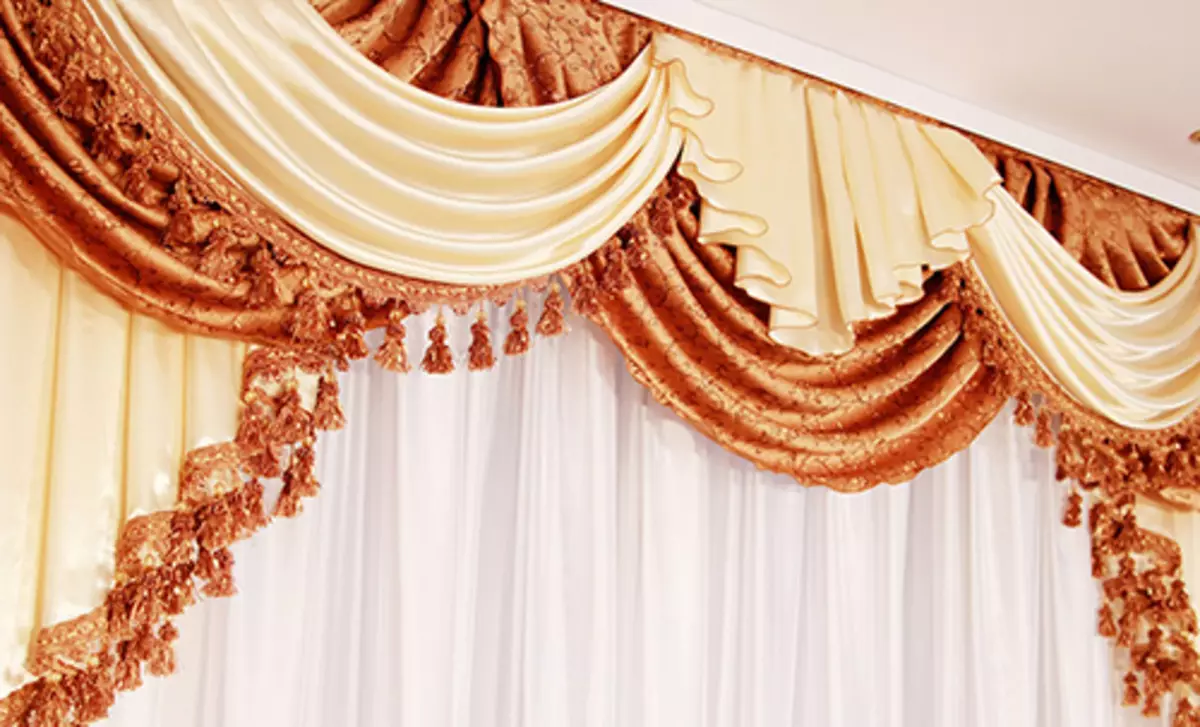
The original decoration of the curtain window with Lambreken gives the whole room sophistication and shows a sense of style of its owner.
If you sear the usual straight curtains of the classic option is not too difficult, then perform a more complex design, to cut the lambrequin, without having experience crumbling of various products, not so simple. However, having studied some techniques, realizing the principle of building patterns on ready-made examples, you can learn how to lure the lambrequin curtains of any complexity.
The main types of Labrekenov
Labreken is a separate horizontal part of the curtain, located at the top of the curtains. This item serves to decorate in the design of window openings, giving the designs of sophistication and a special style. Lambreken can disguise not too fashionable eaves, update a slightly outdated curtain, giving it a new sound. Properly chosen lambrequen is able to change the interior of the room as a whole, the various clock options can visually resize the windows - to reduce, make the window opening "above" or "below". The lambrequins are draped and straight (band). It is not difficult to perform the cutting of the hard bandage, so we will pay attention to the cut of the draped lambrequins. They are very diverse and the following terms are applied to designate their options:
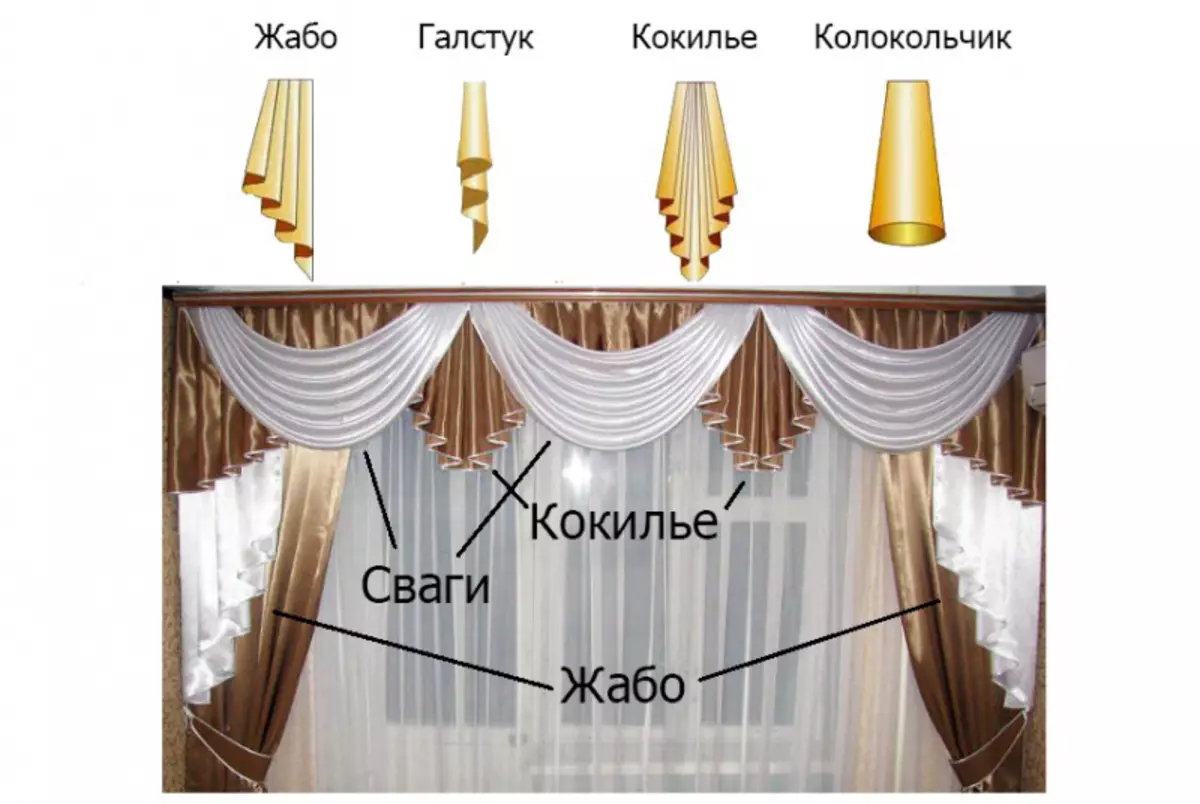
There are many types of lambrequin drapets, applying which for the design of openings you can achieve a visual effect of changing the size of both the windows and the whole room.
- Swagi is a semicircular drapery with uniformly embedded folds or assembly. If the drapery is laid with a tape or a typewriter, then this is "mechanical swagge". Basically, the direction of the folds make along the cornice. But there are both vertical swarps when the folds are laid on the line, perpendicular to the cornice line.
- The cakes are a type of switch, but with a vacurate fabric forming a free space between the shoulders.
- De Jabro - the kind of lambrequin, collected by one slice. The second slice is fluent in free, forming a beautiful wave-like assembly. De Zabo can cover different forms - symmetrical, asymmetrical, angular, double, multi-layered. It is not difficult to cut such a curtain, so this type of decoration is quite commonly used in self-making curtains.
- Kokille is a kind of variety de Zhabo, but necessarily a symmetric look. Folds in this case are embedded from shorter edges to a longer middle. But, the form of Kokille "On the contrary", when the edges are longer, and the middle is short.
- The bell is a detail of a lambrequin, resembling a bell form. Used to decorate the edges of the composition, can also play the role of inserts between the Swag.
- Tie is a narrow elongated element with a scarf shape in the form of a spiral. Used as the bell tape for the edges and for inserts.
Article on the topic: How to calculate the thickness of the walls of the brick?
Learning to cut the lambrene
Consider the technology of cutting the main types of lambrequins.Symmetric Swag.
The cutting of a symmetric wagon can be considered as the basis for cutting all the options for switch and cakes.
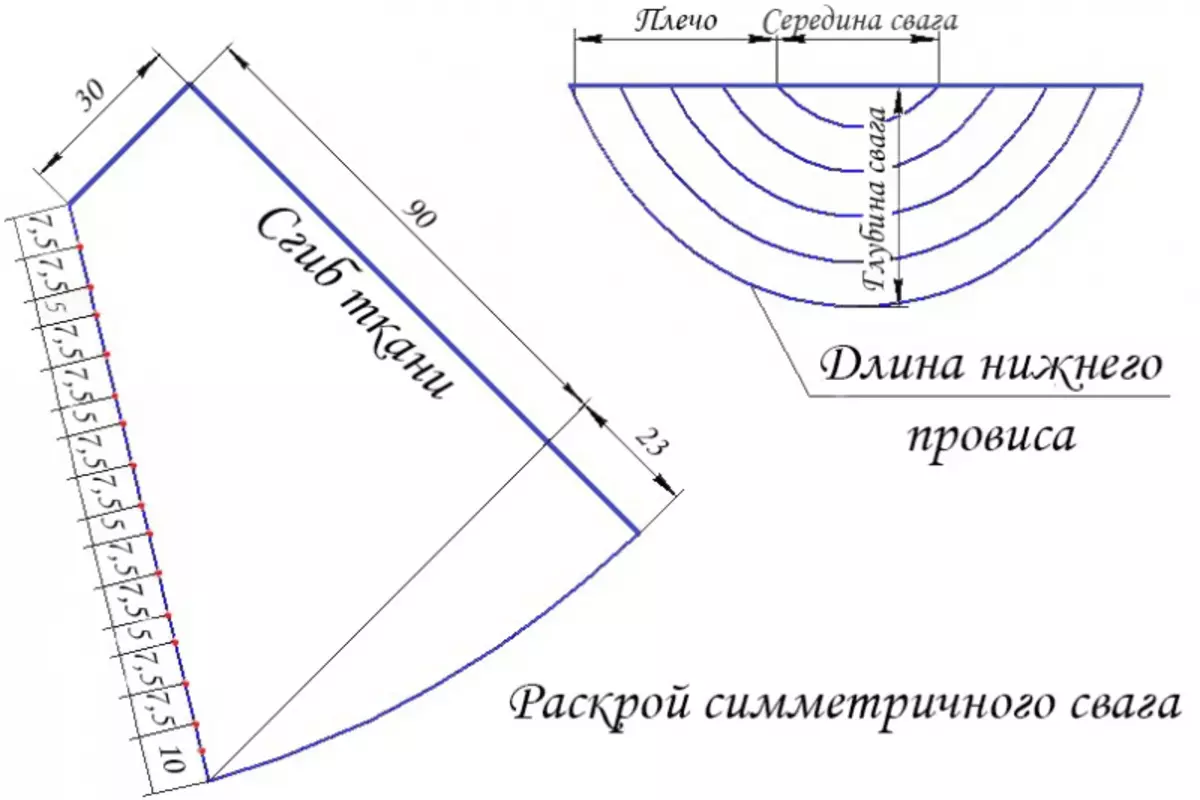
Scheme cutting a symmetric wagon.
The best solution is to perform the cutting line curtains. In this case, the drapery will turn out perfectly smooth, without chances. But in some cases you can draw in the direction of the basis. For example, if there is a strict geometric pattern on the tissue, which is undesirable to break, or the tissue is insufficient. In the case of sewing lambrequins, the following terminology applies:
- The middle of the Swag is a plot without folds in the center of the element.
- Shoulder is draped edges. In the case of a symmetric match, the shoulder size will be the same, and in the case of an asymmetric design, one shoulder will be narrow, and the other is wide.
- The depth is height from top to bottom in the middle of the design.
- Length of the lower wire is the size of the edge measured by the Niza line.
First, do the finished lambrene in the natural value. Suppose that it will have the following dimensions: the middle of the Svaga 40 cm, the shoulders of 30 cm, the depth of 45 cm, half the length of the lower wire (from the edge to the middle) 85 cm. So that the lambrene is as a result, it is precisely such a sizes that we do the following:
- We curb the fabric on the oblique line and perpendicularly the collar take the line, the total length of which is equal to half the middle of the Swag plus the size of the processing (7-10 cm). In our case, it will be 20 + 10 = 30 cm.
- Along the fold line, reflect the value equal to the double depth, that is, 45 x 2 = 90 cm. Then, along the same line, we add half the depths (another 23 cm).
- From the point to which we measured 90 cm, we carry out perpendicular to the length equal to half the length of the lower wire - 85 cm.
- We combine the resulting point with the line of the middle of the Swag - we get a shoulder on which the folds will be laid.
- The bottom point on the bending of the fabric connect the smooth line with the extreme point of the shoulder.
Article on the topic: How to charge the battery without a phone?
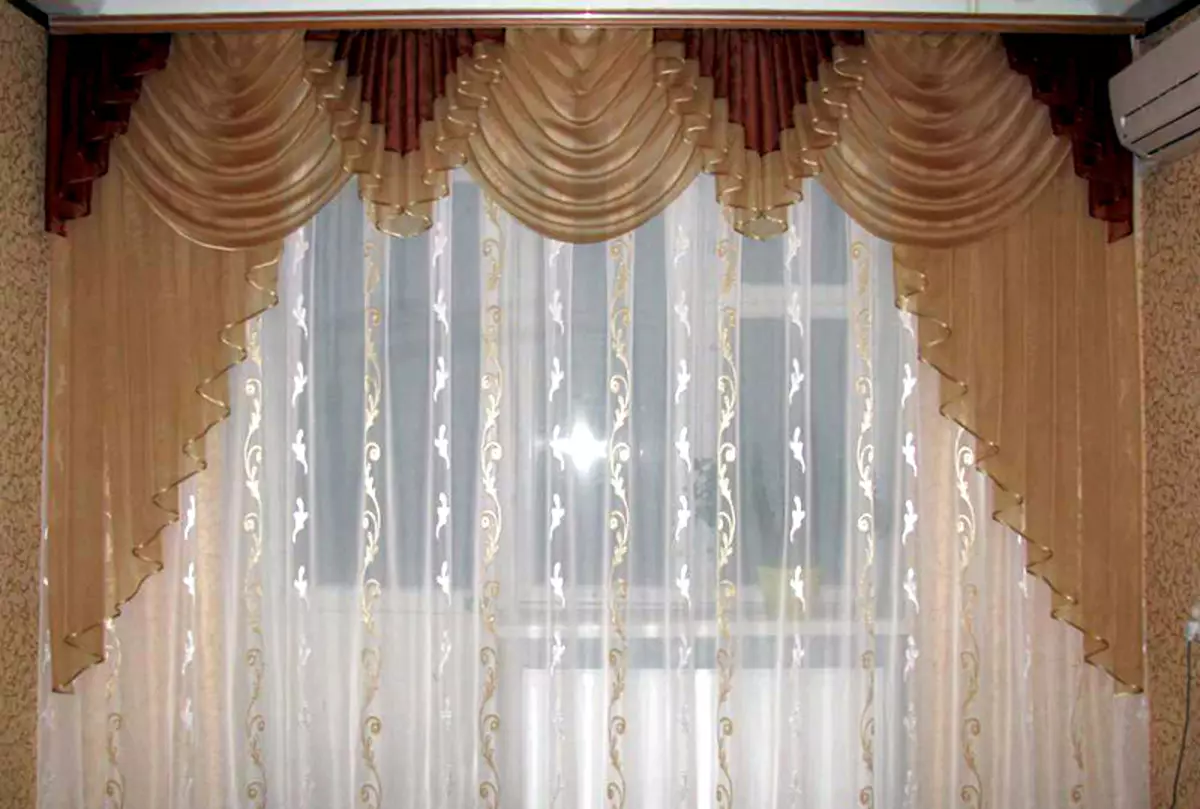
A symmetric SWGA is one of the simple and at the same time interesting details of the lambrequin, on the basis of the pattern of which you can cover any types of swarps and cakes.
Curtain pattern is ready, now you need to put folds correctly. Usually there are 5 pieces, the first is laid from the end of the middle. 10 cm fabrics from the edge remain free. Thus, the distance between the folds will be (30-10): 4 = 5 cm. We measure the distance obtained in the drawing drawing, will read 30 cm from it and what happens, we divide by 5. We will get a number equal to half Fold depths. With regard to the size selected here, the depth of the fold should turn out to be 7.5 cm. Marking is done in this way: from the angle formed by the "mid-match" and shoulder, sequentially deposit the following distances: 7.5 cm, 7.5 cm, 5 cm. This Size range repeat along the entire line. After me, I measure 2 times at 7.5 cm, it should remain 10 cm. If it is a curtain - mechanical swag, then the shoulders are simply going to the curtain tape.
How to kroit de Zabo?
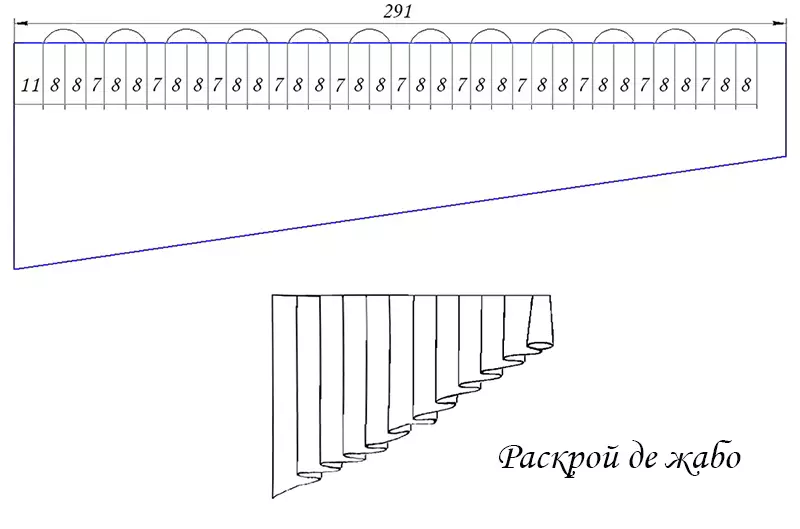
The scheme of cutting lambrequin de Zabo.
Curtains decorated with de Zabo, look very elegant, and the cutter is performed very easily. First we define the form of lambrequin, it is better to draw it on paper. If the curtains are symmetrical, then the pattern is built for half the product. In the case when lambrequin is selected with a smooth edge, without drops in height, the pattern will look very simple. To the desired curtain width (which is often equal to the length of the eaves), add the number of folds multiplied by their dual depth. We will have a long and low rectangle. For example, we will make calculation for de zabs with a width of 1 m wide. With the edge, we will make indents of 8 cm. The remaining distance is divided by the number of folds (12 pieces). It turns out (100-8 * 2): 12 = 7 cm. This we received the distance between the folds. The depth of the folds take 8 cm for 8 cm, that is, on the entire fold of 16 cm. We count the total width of the curtains-lambrequin, it turns out 16 + 77 + 12 * 16 + 6 = 100 + 192 + 6 = 291 cm. Here the 6 cm increase will go for processing the edges. If de Zabo has different heights at the beginning and at the end, then you first need to calculate the width, then on one side it is to postpone the height of one edge on one side, and on the other hand, the height of the second edge, then connect the lower points of one straight line, or the curved line, depending on Sima Curtains.
Article on the topic: How to polish furniture at home
Cutting lambrequins Kokil, bell, tie
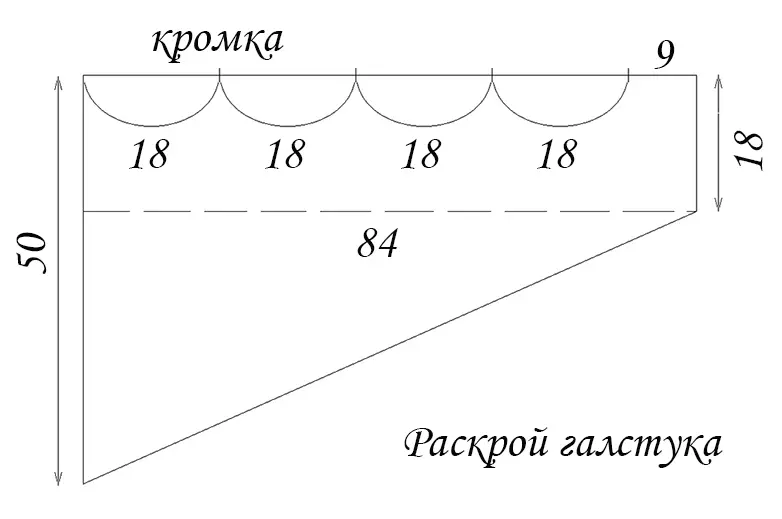
Diagram of cutting lambrequin tie.
This is a very beautiful element of the finish of the curtains. Kokil may be divergent from one point, can be with a straight top. In this case, such a lambrequin is similar to de Jabn, but only the middle is symmetrically elongated, or is shortened relative to the edges. Cutting similar to de Zabo. Since this element of the lambrequin is most often from light transparent tissues, it is performed on the lining. The bell is cut out of 2 parts, similar to wedges, differing from each other by the form of the lower cut. The back of the bell is obtained with the provisity, and the front - with the cloth climb.
Tie lies on the oblique line. First, they draw the main pattern (molds), where the height of the lower and the highest point of the construct is taken into account. Then the milestone is cut, spread the wedges and moor the new pattern.
